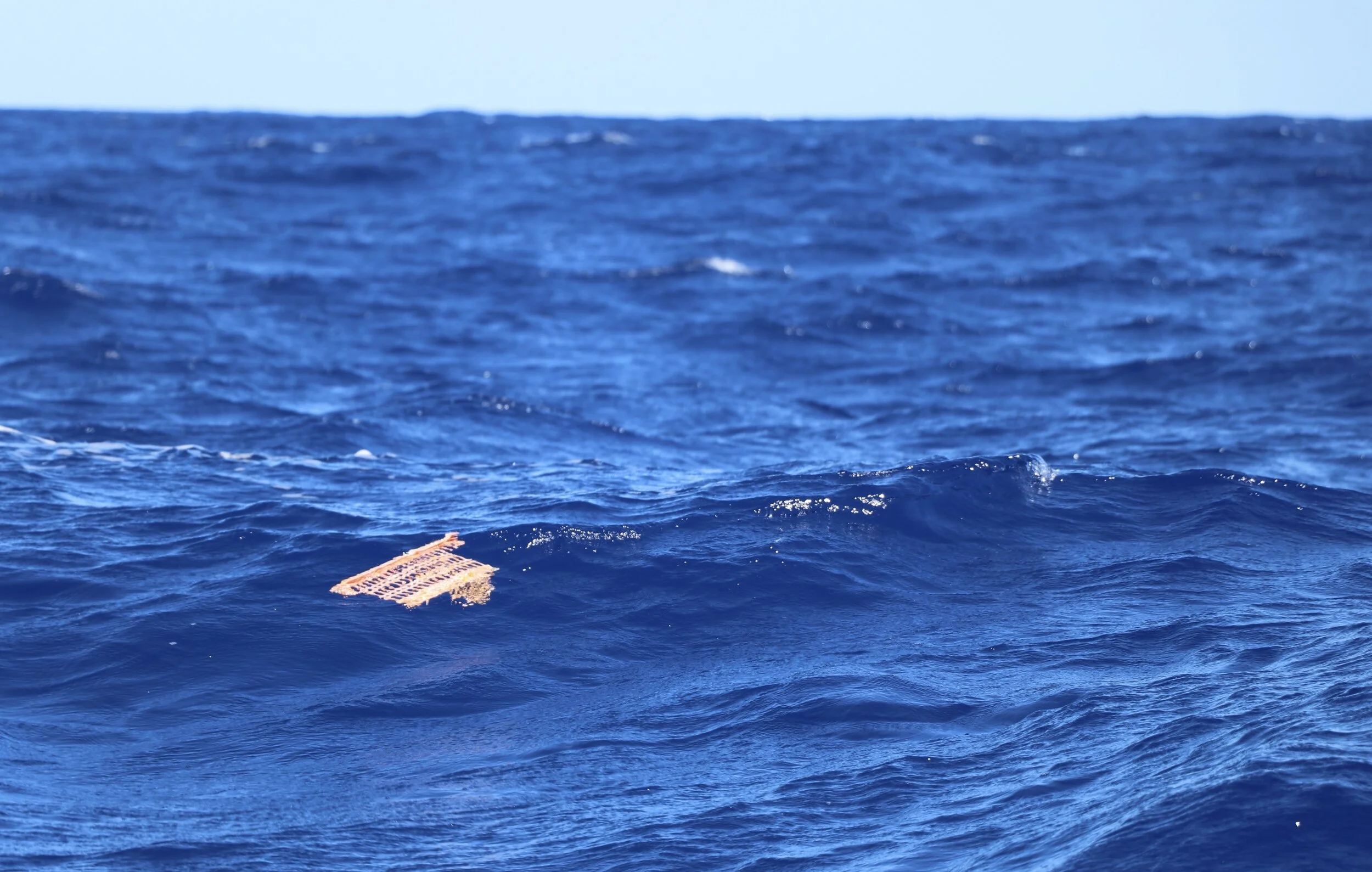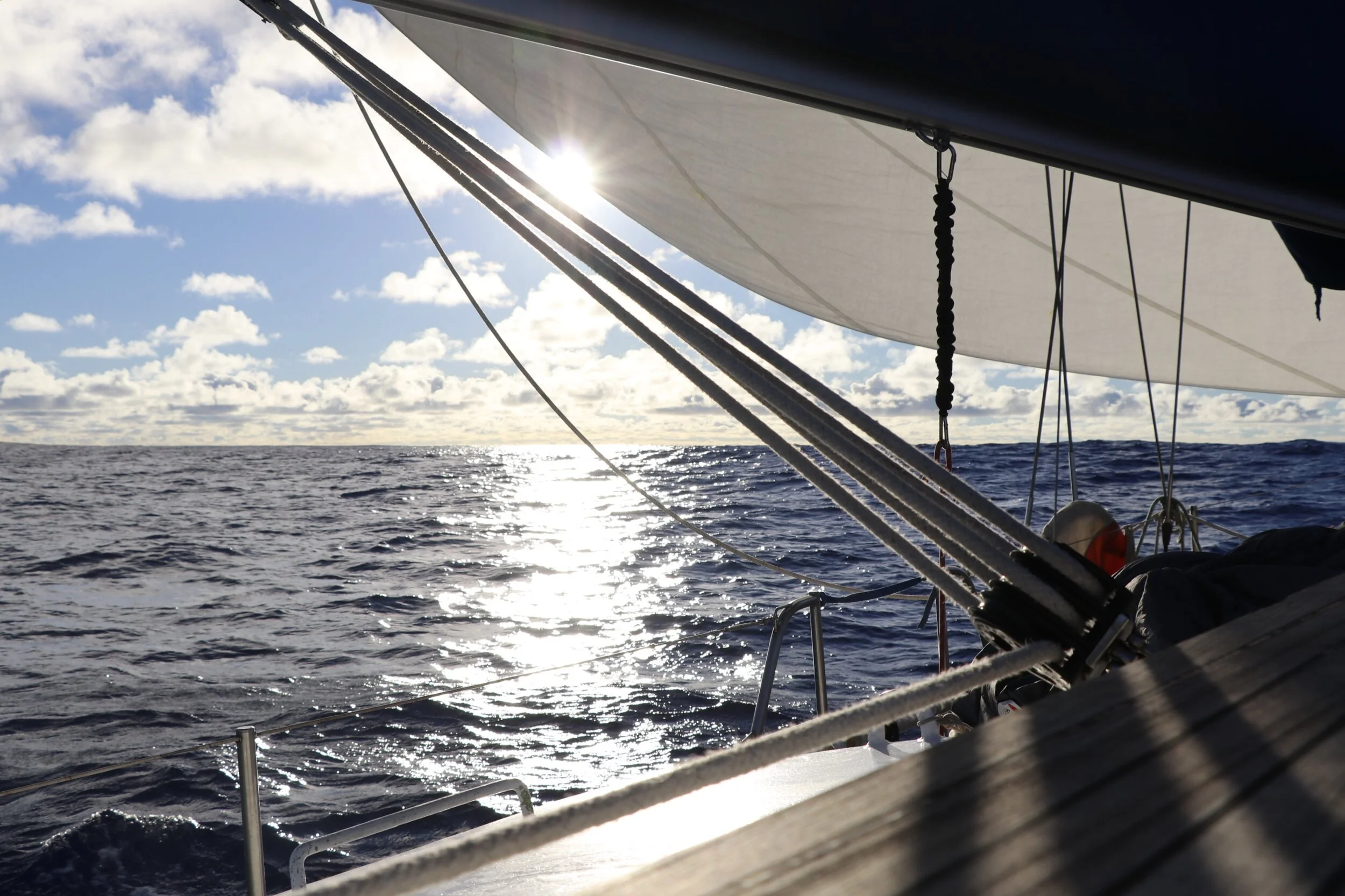Charles Moore is now a two-time Garbage Patch discoverer (and I can tell you what a Garbage Patch looks like)
By Erica Cirino, Safina Center Launchpad Fellow
S/Y Christianshavn in the North Pacific Gyre, November 2016. Photo: Erica Cirino/Chris Jordan
On November 1, 2016, I set out with a group of Danish sailors and scientists associated with nonprofit Plastic Change in an old-school sloop called the SY Christianshavn to cover more than 3,000 miles from Marina Del Ray, California, to Honolulu, Hawaii, in search of plastic. The goal: cross the “Great Pacific Garbage Patch,” a huge accumulation of (mostly plastic) trash swirling in a clockwise current, or gyre, in the North Pacific Ocean between the U.S. West Coast and Asia. Oceanographer and sailboat racing captain Charles Moore had discovered the Patch in 1997.
Despite much research, the size and significance of the plastic patch in the North Pacific Gyre is still not well understood. But even less understood is the South Pacific Gyre, an area encompassing a counterclockwise current swirling between South America and Australia. One day after my ship left, 20 miles south in Long Beach, another sailboat left port for a plastic voyage across the South Pacific. It was Moore’s ORV Alguilta, a catamaran associated with Algalita (his nonprofit).
In April, Moore announced from his ship that he and his crew had discovered a similar—possibly even larger—collection of plastic in the South Pacific. This makes Moore a two-time Garbage Patch discoverer.
Moore and his crew had sailed from Long Beach, California, through the Galapágos Islands, to Concón, Chile, and back, collecting fish and plastic samples along the way. He has recently written online that he will publish a report analyzing his findings shortly, to be published on his website.
The only other research team to collect plastic samples in the South Pacific Gyre before Moore was that led by Marcus Eriksen of 5 Gyres, another California nonprofit focused on studying and bringing attention to the planet’s plastic pollution problem, in 2011. Eriksen had reported seeing very little debris during his expedition, and later published a study on his findings. Indeed, compared to the North Pacific Gyre, it seemed like the South Pacific contained significantly less plastic.
Sunset on the North Pacific Gyre, November 2016. Photo: Erica Cirino
However, early Moore’s new research suggests that the South Pacific Gyre may be even more densely packed with plastic than the North Pacific, and larger, possibly covering a million square meters. The difference between what Eriksen saw in 2011 and what Moore saw on his recent trip may be due to ocean currents carrying more plastic into the South Pacific and an increased amount of plastic production and pollution worldwide.
The majority of plastic Moore, Eriksen and my crew collected was microplastic—tiny bits of plastic 5 millimeters in diameter or smaller. As I’ve explained previously, plastic never breaks down. Rather, it breaks up into smaller and smaller pieces, thanks to wind, waves and a sun-driven chemical reaction called photodegradation.
Part of a laundry basket floating in the North Pacific Gyre seen on my expedition with Plastic Change, November 2016. Photo: Erica Cirino
1 mm diameter microplastic scooped out of the North Pacific Gyre on my expedition with Plastic Change, November 2016. Photo: Erica Cirino
And these small bits of plastic more easily accumulate toxins and take on the appearance of fish eggs, algae and plankton, which marine animals like to eat. As a result, marine wildlife is not only at risk of being entangled in large plastic ropes and other “intact” items in the sea, but they are now being choked and poisoned by these tiny plastic bits. Today it’s estimated that 8 million tons of plastic get into the oceans every year, mostly from being used and improperly disposed of on land.
Plastic is so pervasive it can be found in the bodies of more than 50 percent of the world’s sea turtles, and scientists say 90 percent of all seabirds have ingested plastic at some point in their lives. Fish and marine invertebrates also contain plastic and appear to consume it in large quantities when it is available—and it’s clear there’s plenty of it to eat, even on the ocean floor.
“Remember eating sprinkles on cupcakes as a kid? The tiny little colorful sugary beads…” Moore wrote in January on his expedition blog. “So colorful and delicious and always associated with good times…! But, if you spilled them, man oh man, what a task it was to clean up all those hundreds of colorful tiny sprinkles. This thought has been running through my head over the last few days as we’ve been inspecting more and more trawls heavily laden with plastic….”
As someone who has witnessed this science firsthand, I can attest that Moore’s sprinkle analogy is an accurate one. While in the North Pacific my crew collected plastic samples as well, using the same kind of device—a manta trawl—which we dragged alongside our ship for four hours at a time before bringing it up and checking it to see what we “caught.” Inside its net were dozens to hundreds of little plastic pieces: some jagged, some round, some colorful, some clear. Very sprinkle-like, indeed.
Plastic Change crew uses manta trawl to scoop up plastic from the surface of the North Pacific Gyre, November 2016. Photo: Erica Cirino
Microplastic scooped from shallow waters at Kamilo Beach, Big Island, Hawaii, November 2016. Kamilo Beach lies right in the path of the North Pacific Gyre. Photo: Erica Cirino
I want to add that besides being accurate, Moore’s analogy is pretty ironic too, because microplastic is now being found in some of the foods that people eat, mostly seafood and sea salt. Just something to consider the next time you go grocery shopping.
When you’re sailing across a plastic garbage patch you sometimes see these little bits of plastic peppered on the water’s surface, usually in clumps. You sometimes also see larger items like fragments of plastic laundry baskets, abandoned fishing traps, 200-lb tangles of ropes and nets, dustpans, wayward buoys and more. But these randomly and infrequently float by.
Sailing the North Pacific Gyre, November 2016. “Garbage Patch” is a misnomer for these oceanic trash accumulation hotspots. There is a lot of plastic, it’s just not highly visible all. Photo: Erica Cirino
So, the “Patch” isn’t a giant, thick mat of trash as perhaps you’ve been lead to believe. Instead, the plastic is dispersed and often hides just below the surface, pushed down by wind and waves. And of course, much of it is microplastic so small it’s hard and sometimes impossible to see. Until you pull it up with your manta trawl….







